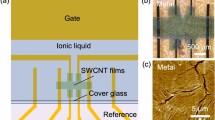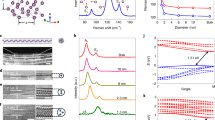Abstract
A common feature of the single-walled carbon-nanotube field-effect transistors fabricated to date has been the presence of a Schottky barrier at the nanotube–metal junctions1,2,3. These energy barriers severely limit transistor conductance in the ‘ON’ state, and reduce the current delivery capability—a key determinant of device performance. Here we show that contacting semiconducting single-walled nanotubes by palladium, a noble metal with high work function and good wetting interactions with nanotubes, greatly reduces or eliminates the barriers for transport through the valence band of nanotubes. In situ modification of the electrode work function by hydrogen is carried out to shed light on the nature of the contacts. With Pd contacts, the ‘ON’ states of semiconducting nanotubes can behave like ohmically contacted ballistic metallic tubes, exhibiting room-temperature conductance near the ballistic transport limit of 4e2/h (refs 4–6), high current-carrying capability (∼25 µA per tube), and Fabry–Perot interferences5 at low temperatures. Under high voltage operation, the current saturation appears to be set by backscattering of the charge carriers by optical phonons. High-performance ballistic nanotube field-effect transistors with zero or slightly negative Schottky barriers are thus realized.
This is a preview of subscription content, access via your institution
Access options
Subscribe to this journal
Receive 51 print issues and online access
$199.00 per year
only $3.90 per issue
Buy this article
- Purchase on Springer Link
- Instant access to full article PDF
Prices may be subject to local taxes which are calculated during checkout




Similar content being viewed by others
References
Heinze, S. et al. Carbon nanotubes as Schottky barrier transistors. Phys. Rev. Lett. 89, 106801 (2002)
Appenzeller, J. et al. Field-modulated carrier transport in carbon nanotube transistors. Phys. Rev. Lett. 89, 126801 (2002)
Heinze, S., Radosavljevic, M., Tersoff, J. & Avouris, P. Unexpected scaling of the performance of carbon nanotube transistors. Preprint at 〈http://xxx.lanl.gov/cond-mat/0302175〉 (2003).
White, C. T. & Todorov, T. N. Carbon nanotubes as long ballistic conductors. Nature 393, 240–242 (1998)
Liang, W. et al. Fabry-Perot interference in a nanotube electron waveguide. Nature 411, 665–669 (2001)
Kong, J. et al. Quantum interference and ballistic transmission in nanotube electron wave-guides. Phys. Rev. Lett. 87, 106801 (2001)
Zhou, C., Kong, J. & Dai, H. Electrical measurements of individual semiconducting single-walled nanotubes of various diameters. Appl. Phys. Lett. 76, 1597 (1999)
Rosenblatt, S. et al. High performance electrolyte gated carbon nanotube transistors. Nano Lett. 2, 869–915 (2002)
Javey, A. et al. High-k dielectrics for advanced carbon-nanotube transistors and logic gates. Nature Mater. 1, 241–246 (2002)
Guo, J. et al. Assessment of silicon MOS and carbon nanotube FET performance limits using a general theory of ballistic transistors. IEE Int. Electron Devices Meeting Tech. Dig. 711–714 (December 2002)
Javey, A., Shim, M. & Dai, H. J. Electrical properties and devices of large-diameter single-walled carbon nanotubes. Appl. Phys. Lett. 80, 1064–1066 (2002)
Martel, R. et al. Ambipolar electrical transport in semiconducting single-wall carbon nanotubes. Phys. Rev. Lett. 87, 256805 (2001)
Mandelis, A. & Christofides, C. Physics, Chemistry and Technology of Solid State Gas Sensor Devices (Wiley, New York, 1993)
Leonard, F. & Tersoff, J. Role of Fermi-level pinning in nanotube Schottky diodes. Phys. Rev. Lett. 84, 4693–4696 (2000)
Zhang, Y., Franklin, N., Chen, R. & Dai, H. Metal coating on suspended carbon nanotubes and its implication to metal-tube interactions. Chem. Phys. Lett. 331, 35–41 (2000)
Zhang, Y. & Dai, H. Formation of metal nanowires on suspended single-walled carbon nanotubes. Appl. Phys. Lett. 77, 3015–3017 (2000)
Kane, C. L. et al. Temperature dependent resistivity of single wall carbon nanotubes. Euro. Phys. Lett. 6, 683–688 (1998)
Fischer, J. E. et al. Metallic resistivity in crystalline ropes of single-wall carbon nanotubes. Phys. Rev. B 55, R4921–R4924 (1997)
Yao, Z., Kane, C. L. & Dekker, C. High-field electrical transport in single-wall carbon nanotubes. Phys. Rev. Lett. 84, 2941–2944 (2000)
Wind, S. J., Appenzeller, J., Martel, R., Derycke, V. & Avouris, P. Vertical scaling of carbon nanotube field-effect transistors using top gate electrodes. Appl. Phys. Lett. 80, 3817–3819 (2002)
Guo, J. & Lundstrom, M. A Computational study of thin-body, double-gate, Schottky barrier MOSFETs. IEEE Trans. Elec. Dev. 49, 1897–1902 (2002)
Guo, J., Lundstrom, M. & Datta, S. Performance projections for ballistic carbon nanotube field-effect transistors. Appl. Phys. Lett. 80, 3192–3194 (2002)
Sze, S. M. Physics of Semiconductor Devices (Wiley, New York, 1981)
Rahman, A., Guo, J., Datta, S. & Lundstrom, M. Theory of ballistic nanotransistors. IEEE Trans. Electron Dev. and IEEE Trans. Nanotechnol. (Joint Special Issue on Nanoelectronics) (in the press).
Kong, J., Soh, H., Cassell, A., Quate, C. F. & Dai, H. Synthesis of individual single-walled carbon nanotubes on patterned silicon wafers. Nature 395, 878–881 (1998)
Soh, H. et al. Integrated nanotube circuits: Controlled growth and ohmic contacting of single-walled carbon nanotubes. Appl. Phys. Lett. 75, 627–629 (1999)
Odintsov, A. A. Schottky barriers in carbon nanotube heterojunctions. Phys. Rev. Lett. 85, 150–153 (2000)
Leonard, F. & Tersoff, J. Novel length scales in nanotube devices. Phys. Rev. Lett. 83, 5174–5177 (1999)
Nakanishi, T., Bachtold, A. & Dekker, C. Transport through the interface between a semiconducting carbon nanotube and a metal electrode. Phys. Rev. B 66, 073307 (2002)
Kim, W. et al. Hysteresis caused by water molecules in carbon nanotube field effect transistors. Nano Lett. 3, 193–198 (2003)
Acknowledgements
We thank P. McEuen, W. Harrison, D. Antoniadis, J. Bokor and J. Tersoff for insights and sharing preprints/unpublished results, and D. Wang for SEM. The work at Stanford was supported by the MARCO MSD Focus Center, DARPA/Moletronics, SRC/AMD, and the Packard, Alfred Sloan and Dreyfus foundations. The work at Purdue was supported by the National Science Foundation Nanoscale Modeling and Simulation Program and by the Network for Computational Nanotechnology.
Author information
Authors and Affiliations
Corresponding author
Ethics declarations
Competing interests
The authors declare that they have no competing financial interests.
Rights and permissions
About this article
Cite this article
Javey, A., Guo, J., Wang, Q. et al. Ballistic carbon nanotube field-effect transistors. Nature 424, 654–657 (2003). https://doi.org/10.1038/nature01797
Received:
Accepted:
Issue Date:
DOI: https://doi.org/10.1038/nature01797
This article is cited by
-
Nano-assembled open quantum dot nanotube devices
Communications Materials (2024)
-
Carbon nanomaterials for sweat-based sensors: a review
Microchimica Acta (2024)
-
Chirality-dependent electrical transport properties of carbon nanotubes obtained by experimental measurement
Nature Communications (2023)
-
Complementary carbon nanotube metal–oxide–semiconductor field-effect transistors with localized solid-state extension doping
Nature Electronics (2023)
-
The future transistors
Nature (2023)
Comments
By submitting a comment you agree to abide by our Terms and Community Guidelines. If you find something abusive or that does not comply with our terms or guidelines please flag it as inappropriate.



